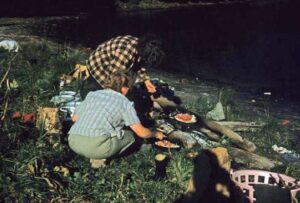Cook — Kenirluni, Uuceslluku
Nulima keniyaskiinga akgua’aq sitiin’kamek. – My wife cooked me pork chops last night.

Food traditions are central aspect of a society’s cultural identity. The foods that people eat, and the dishes they make from these foods, are some of the most deeply held social customs. People who immigrate to new lands or whose societies are impacted by colonization typically maintain their traditional cuisines. Alutiiq people are no exception. The rich seafoods of the traditional diet are a cherished part of modern meals, and many favorite subsistence foods are incorporated into dishes introduced by Russian, Scandinavian, American, and Asian settlers.
Cooking subsistence foods is a joyful act. Alutiiq people are proud to feed their families fresh, local foods, which are seen as cleaner and healthier than the groceries available in stores. Moreover, social gatherings are not complete without an array of dishes made from Kodiak resources: herring eggs on eelgrass, smoked salmon, fish pie, baked halibut, seal soup, and for dessert, salmonberry tarts and berries mixed with fat, sugar, and milk.
Before the availability of stoves and metal pots, Alutiiq people cooked over open fires with tools crafted from cedar driftwood. Because cedar naturally repels water, its fragrant wood was an excellent choice for cooking tubs, bowls, dishes, and spoons. Chefs boiled water and heated soups and stews by dropping hot stones into wooden dishes, tightly woven grass baskets, or by setting large clay pots directly in the fire. Wooden containers from archaeological sites bear burn marks from red-hot rocks. People also cooked by roasting foods over the fire, placing food on hot slabs of stone, baking items in pits filled with hot coals, or fermenting foods in leaf-lined pits.
Listen to podcast at the Alutiiq Museum website
